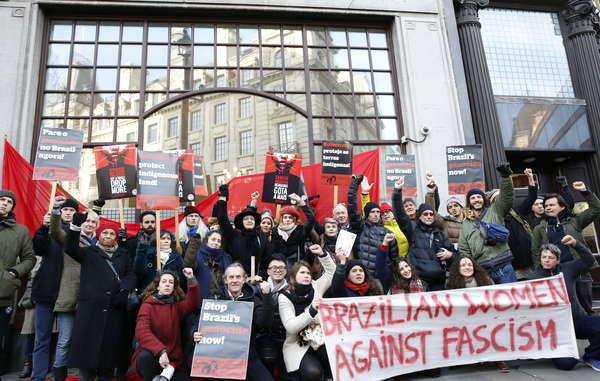
by Deep Green Resistance News Service | Jan 31, 2019 | Protests & Symbolic Acts
by Survival International
Protests against the anti-indigenous policies of Brazil’s President Bolsonaro are occurring in Brazil and around the world to mark his first month in power.
Demonstrators held placards declaring “Stop Brazil’s genocide now!” and “Bolsonaro: protect indigenous land.”
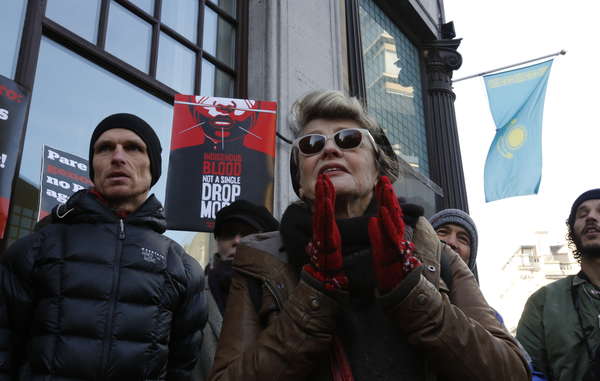
Oscar winning actor Julie Christie joins Survival protesters outside Brazils Embassy in London, calling on Bolsonaro to stop Brazil’s genocide. © Rosa Gauditano/APIB/Survival International
The protests have been
led by APIB, the Association of Indigenous Peoples of Brazil, as the culmination of their “Indigenous blood – not a single drop more” campaign, known as “Red January.”
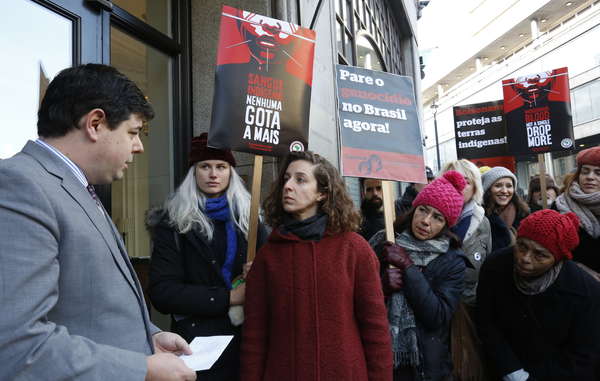
Protesters handed in a letter to Brazilian Embassy officials calling on President Bolsonaro to abandon his crackdown on indigenous rights. © Rosa Gauditano/APIB/Survival International
Before he was elected president, Mr Bolsonaro was
notorious for his racist views. Among his first acts on assuming power was to remove responsibility for indigenous land demarcation from Brazil’s Indigenous Affairs Department
FUNAI, and hand it to the notoriously anti-Indian Agriculture Ministry, which
Survival labelled “virtually a declaration of war against Brazil’s tribal peoples.”
President Bolsonaro also moved FUNAI to a new ministry of Women, Family and Human Rights headed by an evangelical preacher, a move designed to drastically weaken FUNAI.
Emboldened by the new President and his long history of anti-indigenous rhetoric, attacks by ranchers and gunmen against Indian communities have risen dramatically.
The territory of the Uru Eu Wau Wau Indians, for example, has been invaded, endangering uncontacted tribespeople there; and hundreds of loggers and colonists are planning to occupy the land of the Awá, one of Earth’s most threatened tribes.
But Brazil’s indigenous people have reacted with defiance. “We’ve been resisting for 519 years. We won’t stop now. We’ll put all our strength together and we’ll win,” said Rosilene Guajajara. And Ninawa Huni Kuin said: “We fight to protect life and land. We will defend our nation.”
APIB said: “We have the right to exist. We won’t retreat. We’ll denounce this government around the world.”
Survival International’s Director Stephen Corry said today: “Having suffered 500 years of genocide and massacres, Brazil’s tribal peoples are not going to be cowed by President Bolsonaro, however abhorrent and outdated his views are. And it’s been inspiring to see how many people around the world are standing with them.”

© Rosa Gauditano/APIB/Survival International

© Rosa Gauditano/APIB/Survival International
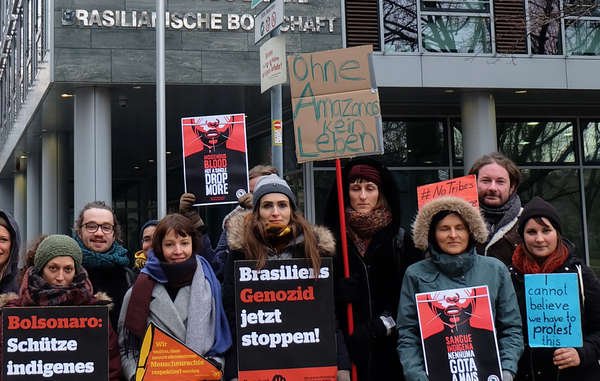
Protesters in Berlin, Germany outside the Brazilian Embassy. © Survival International

Protesters in Madrid, Spain handing a letter to the Brazilian Embassy, calling for an end to indigenous rights violations. © Survival International

Protesters in Milan, Italy outside the Brazilian Consulate. © Survival International

Survival protester hands in a letter to the Brazilian Consulate in Milan, Italy. © Survival International

© Rosa Gauditano/APIB/Survival International
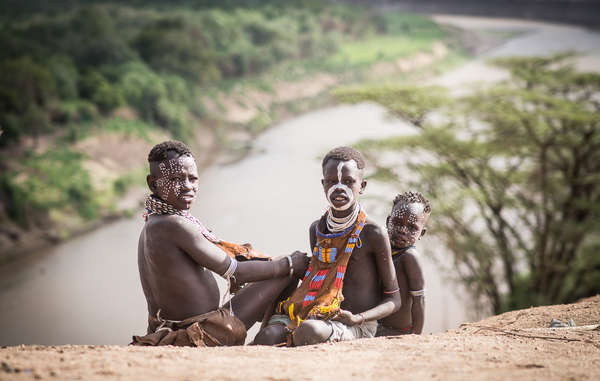
by Deep Green Resistance News Service | Sep 16, 2018 | Biodiversity & Habitat Destruction
Featured image: Lake Turkana and the River Omo, a lifeline to many tribal peoples, are drying up due to mega dam. © Nicola Bailey/ Survival International, 2015
by Survival International
UNESCO added Kenya’s Lake Turkana to its World Heritage Site Endangered List in June, a sign it believes the iconic lake’s survival is at risk.
Experts believe it is drying up largely because of the Gibe III dam, which lies upstream in Ethiopia and was completed in 2016.
For the eight different tribes of Ethiopia’s Omo valley region, the Gibe III dam and related sugar plantations project have already proved devastating. The dam has enabled local authorities to syphon off water from the Omo river to irrigate vast sugar plantations.
Forcibly evicted from their land, many of the country’s tribespeople have lost not only their homes but an entire way of life. The dam has ended the natural flood they depended on for flood retreat agriculture as well as depriving them of access to the river for fishing and for growing their crops.
Survival has received disturbing reports that tribal peoples are suffering from hunger and continue to suffer abuse and harassment if they speak out about the situation. Many communities are under pressure to relocate to government villages, a policy that most oppose.
The dam is also causing problems for the thousands of tribal peoples in northern Kenya who live around Lake Turkana and who fish its waters for their livelihood.
According to Ikal Ang’elei, director of the NGO Friends of Lake Turkana which has campaigned for years against the Gibe III dam: “The lives of local communities now hang in the balance given that their main sources of livelihood are facing extinction. This decision by the UNESCO World Heritage Committee should serve as a notice to Ethiopia to cancel any further dams planned on the Omo River.”
As early as 2010, one such expert predicted that the dam would reduce the lake’s inflow by some 50% and would cause the lake’s depth to drop to a mere 10 meters. “The result could be another Aral Sea disaster in the making,” he warned.
The World Heritage Centre Committee now recognises that the dam has led to “overall rapid decline in water levels” and has meant that seasonal fluctuations have been “heavily disrupted.” As a result, the Committee agrees that “the disruption of the natural flooding regime is likely to have a negative impact on the fish population in Lake Turkana, which may in turn affect the balance of the ecosystem, the livelihoods of the local fishing communities and the floodplains, which support herbivore species.”
UNESCO’s decision follows several years of lobbying by indigenous and international organizations.
The Omo Valley tribes did not give their free, prior and informed consent to the Gibe III dam project, a fact that Survival International highlighted in its submission to the African Commission on Human and Peoples’ Rights.
Despite the mounting evidence of the serious impacts of Gibe III on tribal peoples in Ethiopia and Kenya, the Ethiopian government is currently building another dam on the Omo river called Koysha, or Gibe 4.
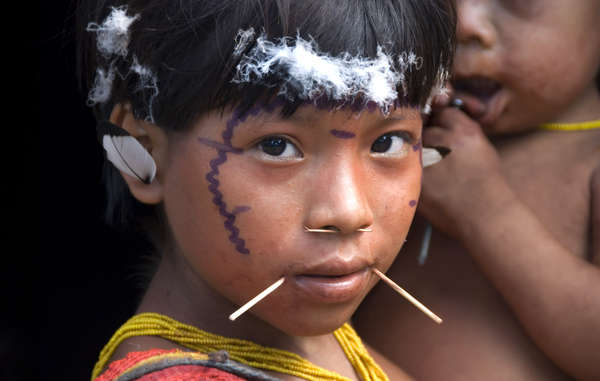
by Deep Green Resistance News Service | Jun 29, 2018 | Colonialism & Conquest
Featured image: The Yanomami are the largest relatively isolated indigenous people in the Amazon. © Fiona Watson/Survival
by Survival International
A measles epidemic has hit an isolated Amazon tribe on the Brazil-Venezuela border which has very little immunity to the disease.
The devastating outbreak has the potential to kill hundreds of tribespeople unless emergency action is taken.
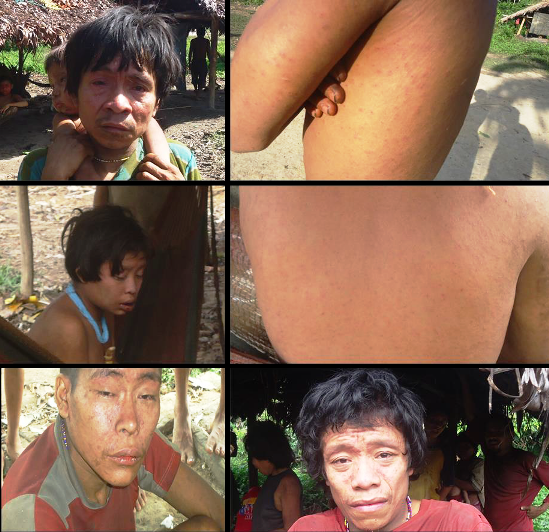
Pictures of Yanomami affected by the current measles outbreak. © Wataniba
The Yanomami communities where the outbreak has occurred are some of the most isolated in the Amazon.
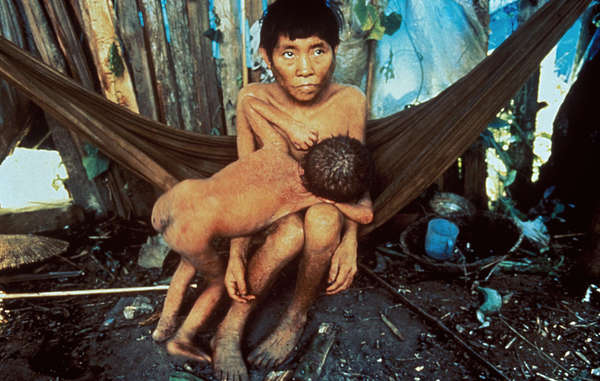
The Yanomami have previously been ravaged by outbreaks of deadly diseases following invasions of their territory by gold miners. © Antonio Ribeiro/Survival
But thousands of gold miners have invaded the region, and they are a likely source of the epidemic. Despite repeated warnings, the authorities have taken little effective action to remove them.
In Brazil, at least 23 Indians have visited a hospital, but most of those affected are far from medical care.
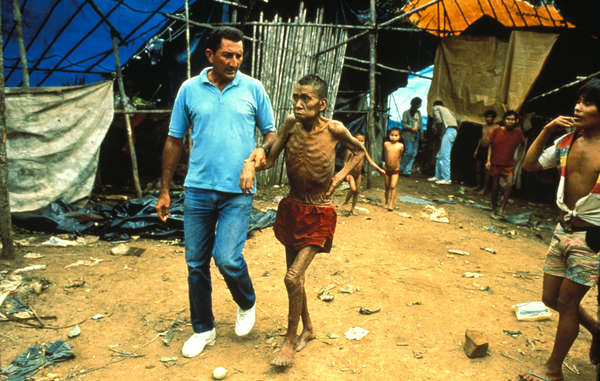
Previous disease outbreaks killed 20% of the Yanomami in Brazil. © Antonio Ribeiro/Survival
Survival International is calling for authorities in Venezuela to provide immediate medical assistance to these remote communities.
Survival’s Director Stephen Corry said today: “When tribal people experience common diseases like measles or flu which they’ve never known before many of them die, and whole populations can be wiped out. These tribes are the most vulnerable peoples on the planet. Urgent medical care is the only thing standing between these communities and utter devastation.”
The Venezuelan NGO Wataniba has released further details on the outbreak (in Spanish).
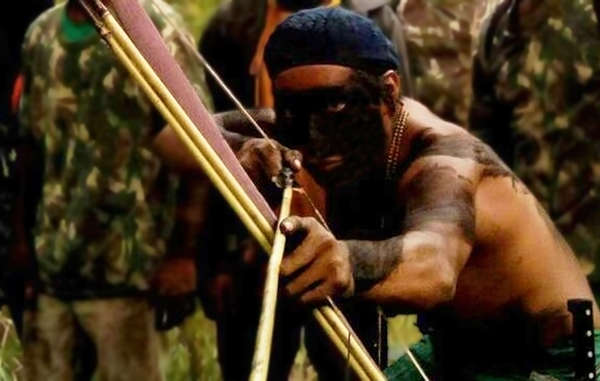
by Deep Green Resistance News Service | May 22, 2018 | Defensive Violence
Featured image: Guardians of the Amazon from the Guajajara tribe: “We patrol, we find the loggers, we destroy their equipment and we send them away. We’ve stopped many loggers. It’s working.” © Guardians of the Amazon
by Survival International
Members of an Amazon tribe patrolling their rainforest reserve to protect uncontacted relatives from illegal loggers have seized a notorious logging gang, burned their truck, and expelled them from the jungle.
The Guardians of the Amazon are from the Guajajara tribe: “We patrol, we find the loggers, we destroy their equipment and we send them away. We’ve stopped many loggers. It’s working.”
The area they are defending, Arariboia, is in the most threatened region in the entire Amazon. It is home to an uncontacted group of Awá Indians, a tribe well known for their affinity with animals and understanding of the forest, who face total annihilation if they come into contact with the loggers.
The Guardians have recently found abandoned Awá shelters close to where the loggers operate.
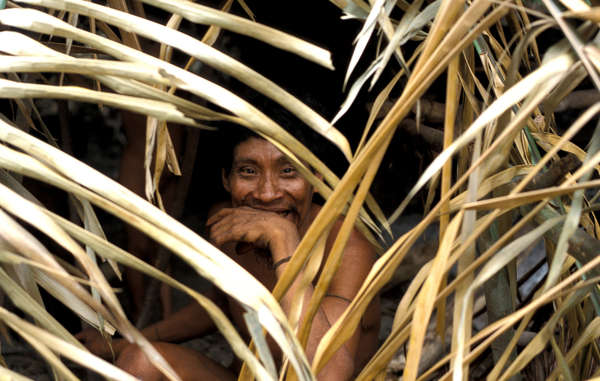
An Awá man called Takwarentxia, who was contacted in 1992 with his wife Hakõa’ĩ, and their baby. The rest of his family were killed by gunmen working for ranchers clearing the land. © Fiona Watson/Survival
They now fear violent retaliation. Three of the Guardians were murdered by loggers in 2016, and they have experienced arson attacks and regular death threats.
Burning Truck from Survival International on Vimeo.
The Guardians sent footage of the burning truck loaded with illegally cut timber to Survival International, along with the message: “Please show the world the reality we face. We know it’s risky and we have enemies but now’s no time for hiding. We want you to release this to the world so we can continue to protect our forest.”
Survival International has written urgently to the Brazilian government calling for the immediate and long term protection of both the Guardians themselves and of the area they fight to protect. Survival are also asking members of the public to send emails in support of the Guardians to government ministers via this page on their website.
Survival’s Director Stephen Corry said: “Tribal territories are the best barrier to deforestation, and these Guardians are defending the last patch of green amid a sea of destruction. It’s further proof that tribal peoples are the best conservationists and guardians of the natural world. The Guardians are virtually the only people standing between the loggers and the uncontacted Awá who still hold out in this forest. The Brazilian government’s inaction in the face of rampant illegal deforestation is shameful.”
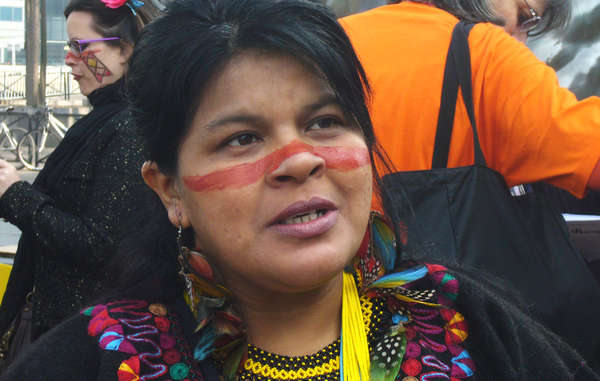
Sônia Guajajara at a protest in Paris against Brazil’s plans for a series of mega-dams in the Amazon, March 2014. © Survival International
She said today: “The Guardians’ work is both extremely valuable and incredibly risky. We indigenous peoples will never accept the ransacking of our Mother Earth – we listen to her and understand the way she talks to us because our life depends on her.”
BACKGROUND BRIEFING
The Guardians of the Amazon
– The “Guardians of the Amazon” are men from the Guajajara tribe in Brazil’s Maranhão state who have taken it upon themselves to protect what remains of this eastern edge of the Amazon rainforest.
– They want to save the land for the hundreds of Guajajara families who call it home, and their far less numerous neighbors: the uncontacted Awá Indians.
– The Guardians say of their work: “We patrol, we find the loggers, we destroy their equipment and we send them away. We’ve stopped many loggers. It’s working.”
– The Guardians recently released video and images of a rare encounter with the uncontacted Awá living in Arariboia. Watch the footage here
– You can see videos of several of the Guardians talking about their work on Survival’s Tribal Voice site.
Uncontacted tribes
– There are more than 100 uncontacted tribes worldwide. They have decided not to engage in regular contact with anyone from the outside world.
– They are not “lost” or trapped in a land that time forgot. They are aware of the outside world, and may engage sporadically with contacted tribes nearby.
– There’s irrefutable evidence that their tribal territories are the best barrier to deforestation, particularly in the Amazon rainforest.
– Uncontacted tribes are the most vulnerable peoples on the planet. Whole populations are wiped out by violence from outsiders who steal their land and resources, and by diseases like the flu and measles to which they have no resistance.
– It is not uncommon for 90% of the population to be wiped out following initial contact.
Awá
– The Awá are a hunter-gatherer people living in the forests of the eastern Brazilian Amazon
– While some Awá are in contact with the outside world, others are uncontacted.
– The Awá were known as “the most threatened tribe in the world” during a successful campaign by Survival International for the Brazilian government to expel the illegal loggers from one of their territories.
– The tribe are known for their affinity with the animals of their forest, and some families have more pets than people, from raccoon-like coatis to wild pigs and king vultures.
– Monkeys are the Awá’s favorites and individuals are often seen with their pet monkey riding on their head. Awá will rescue orphaned baby monkeys and adopt them as a member of the family, even breastfeeding them.
Arariboia
– The Arariboia indigenous territory comprises a unique biome in the transition area between the savannah and the Amazon rainforest.
– There are species here not found elsewhere in the Amazon.
– The land inside the indigenous territory is under threat from illegal loggers
– Brutal cuts in government funding to its indigenous affairs department FUNAI and tribal land protection mean the dangers are now even greater, as the area is not properly monitored or defended by the authorities.
– A powerful and violent logging mafia operates in the region, supported by some local politicians.

by Deep Green Resistance News Service | May 11, 2018 | Indigenous Autonomy
Featured image: With support from Survival, the Guajajara are able to expose illegal logging and threats to their uncontacted neighbors in real time. © Survival
by Sarah Shenker / Survival International
“We are here,” says Olimpio, looking directly into the camera, “… Monitoring the land and protecting the uncontacted Indians and the Guajajara who live here. Why? Because there are some people – anthropologists from some countries – who want, once again, to violate the rights of the uncontacted Indians in the country.”
Olimpio remains calm, but you can sense tension as he continues to speak.
“We are aware that some anthropologists have been calling for ‘controlled contact’ with the uncontacted Indians… We will not allow this to happen, because it would be another genocide.”
Olimpio is among the leaders of a group known as the “Guajajara Guardians,” men from the Guajajara tribe in Brazil’s Maranhão state who have taken it upon themselves to protect what remains of this north-eastern edge of the Amazon rainforest, the hundreds of Guajajara families who call it home, and their far less numerous neighbors: the Awá Indians, some of whom are uncontacted.
Uncontacted tribes are the most vulnerable peoples on the planet, and the Guajajara are acutely aware of this. Whole populations are being wiped out by violence from outsiders who steal their land and resources, and by diseases like flu and measles to which they have no resistance. The Guajajara know that the destruction of the forest, which the Awá have been dependent on and managed for generations, spells doom for the Awá and the Guajajara alike. All uncontacted peoples face catastrophe unless their land is protected. Without it, the Awá simply won’t survive.
The satellite imagery is startling: this territory, known as Arariboia, is an island of green amidst a sea of deforestation in this corner of the Amazon, which has been plundered for its iron ore; opened up by roads and rail; and chopped down for its valuable hardwoods.

The Awá are one of the most vulnerable peoples on the planet. Some of them have no contact with mainstream Brazilian society, though the majority do. © Survival International
The uncontacted nomadic Awá live on a small hill in the centre of this island, where they hunt, fish, and collect fruits and berries. Its forest cover is thicker than that below. Following centuries of invasion, the Awá’s hill has become their refuge. They now number no more than several dozen.
As we looked up towards the uncontacted Arariboia Awá’s forest, it struck me that they really are living on the edge. Following centuries of land invasion and theft, and genocidal violence, they are clinging on against all odds. Preventing their annihilation is a matter of now or never.
I was here to learn about the Guajajara Guardians’ work and to set them up with communications technology as part of Survival International’s Tribal Voice project, which allows remote tribal peoples to send video messages around the globe in real time. It is one of the ways in which we work in partnership with them, and give them a platform to speak to the world. They were very enthusiastic about the possibilities this might offer, allowing them to expose logging and other attacks on Arariboia, and share information from their expeditions to protect their Awá neighbors.
First of all, however, Olimpio decided to record a denunciation of two American academics, Kim Hill and Robert Walker, rejecting outright their calls for forced contact with uncontacted tribes.
“It would be another genocide of a people, of indigenous people, who do not want contact, either with us, or with non-indigenous people” he says. It is hard not to be impressed by his determination.
*
Much of this region of Maranhão doesn’t really feel like the Amazon. The state borders the northeastern coast of Brazil and stretches downwards into the Amazon basin, but you don’t see the thick forests that people generally imagine when they picture the world’s largest rainforest. Instead, much of the area has been given over to agriculture in the form of ranches and plantations, or abandoned after the loggers have had their way with it and moved on.
After driving through countless miles of bleached brown grass, it is refreshing to reach Arariboia. The indigenous territory is home to the Guajajara and Awá peoples. Arariboia and other indigenous territories in the region are virtually the only remaining areas of genuine forest in the state. Crossing the border into indigenous land, things don’t feel all too different at first – in fact, vast swathes of forest in the territory were destroyed by fires last year, believed to have been started by the region’s powerful logging mafia. But the further into the area you head, the more you get the sense that you are in an island of lush greenery in the middle of the destruction so common elsewhere in this part of Brazil.
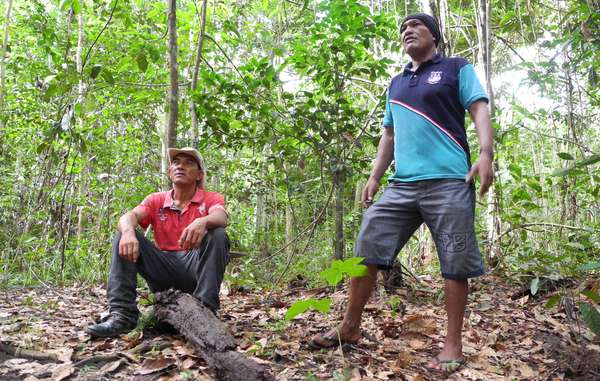
Olimpio and Franciel, coordinators of the Guajajara Guardians, are determined to protect the forest for their uncontacted Awá neighbors. © Survival
Although it is strictly forbidden under Brazilian law for outsiders to fell trees in indigenous territories, here and elsewhere in the Amazon loggers constantly flaunt this with impunity. Just on the drive up to Arariboia we passed dozens of loggers, their trucks piled high with illegally felled logs. I took a photo of one truck driven by two young men looking particularly pleased with their collection, and realized very quickly that they didn’t care. They do not attempt to hide their faces or their operations as they knew that the local government – largely controlled by the mafias who run this trade – will carry on turning a blind eye.
However, it is harder than ever for bandit loggers to operate in Arariboia. The Guardians, of whom there are around fifty, patrol the forest, monitoring, keeping their eyes open, and notifying the authorities. They do it in shifts, in their own time, with only sporadic financial and logistical support from the Brazilian government, despite its formal commitment to protecting the rainforest and indigenous rights. The work is time-consuming and far too much for a small band of committed volunteers. And it’s dangerous: In recent years, several Guajajara have been assassinated.
Why then, do they do it? I found it difficult to fathom at first. It is common for loggers to intimidate and murder indigenous people, so many feel forced into silent acceptance of the loggers and their activities. Sadly in this part of Brazil, many Guajajara also collaborate with the loggers, hoping to make some money from the trade, which they see as unstoppable. Alienated, threatened, and living on the fringes of a society that barely accepts them, the Guardians’ motivation for self-imposed vigilante duty is not outwardly obvious.
*
The more time I spent with the Guajajara in Arariboia, however, the more it seemed to make sense. Members of the tribe who live in the center of their land, closest to the Awá’s hill, are less integrated into mainstream Brazilian society, and feel a stronger sense of connection to their communal ways. They thrive in the forest, knowing it intimately and practising Guajajara rituals.
While I was there I witnessed one of these – a coming of age ceremony for a Guajajara girl. The tribe considers a girl’s first menstruation to be a hugely significant time, marking the passage into adulthood, and celebrate it as a community. The girl spent a week living in a small hut with a palm frond roof, attended by female relatives who would bring her food. Rather than being a solemn isolation, however, the rite of passage is a great celebration, and the Guajajara frequently burst into song and dance, paint their faces and revel in the girl’s new maturity. The men of the village, though not allowed to enter the hut, often come and stand close to the entrance and join in the singing.
Experiencing this put the Guardians’ desire to protect their forest and fellow indigenous people into context. To them, Arariboia is not a resource to be exploited in the name of “progress” and “civilization” – it is fundamental to who they are. They take great pride in it, protect what is left of it, and feel a deep sense of connection to it.
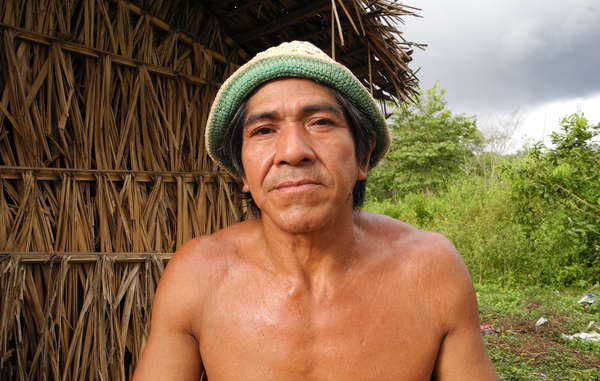
Survival has been working with the Guardians since 2015. © Survival
“People can’t take their land away from them,” another of the Guardians said to me, outraged, as we trekked through the forest close to one of the logging hotspots, “and they can’t take them away from their land.” He was indicating the Awá’s hill, which towers over the surrounding scrubland and lighter forest and provides a focal point in the landscape. The uncontacted Awá living there have expressed their desire to remain uncontacted, and the Guajajara want to see that desire respected.
Some see the centuries-long battle for survival between the indigenous peoples of the Amazon and the colonizers who exploit and destroy it as hopeless. Some, including the American anthropologists who the Guajajara were so keen to refute, see contact as inevitable and isolated uncontacted peoples as doomed. Deforestation will continue, they claim, and so tribal people will either have to assimilate with the Brazilian mainstream, or else face annihilation.
The Guajajara Guardians see it differently. They know what contact, “development,” and “progress” can mean for tribal peoples. They have watched as more and more of the forest that their ancestors were dependent on and managed for generations has been destroyed. And they’re keen to fight back, by boosting their land protection expeditions which are succeeding in keeping loggers out of some key areas, and by sharing their concerns with the world and encouraging international support.
For any tribal people, land is the key to survival. We’re doing everything we can to secure it for them, and to give them the chance to determine their own futures.
That’s also why Survival is giving the Guajajara, and other tribes, communications technology so they can speak to the world in real time. Their understanding of the problems they and their neighbors face is as astute as anyone’s and they have perceptive things to say about almost every aspect of life today. They are not only the best conservationists and guardians of the natural world, but are also at the forefront of the fight for human rights and self-determination. Maybe it’s time to listen.
Sarah Shenker was in conversation with Survival’s Lewis Evans
Act now to support the Guajajara Guardians






















